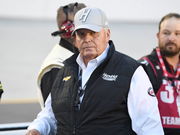

What does a community’s soul look like when faced with a $30 billion transformation? This question is all too familiar to Mooresville, North Carolina, the site of the renowned Dale Earnhardt Museum and the annual Dale Earnhardt Day event. Following Dale Earnhardt’s untimely death at the 2001 Daytona 500, Mooresville, North Carolina, became the center of gravity for grieving fans from all over the nation and the world. “NASCAR has lost its greatest driver ever. And I have lost a great friend,” said Bill France, NASCAR’s chairman of the board. Earnhardt was more than just a racing icon to the people of Mooresville; and his passing was mourned like the death of a family member. And now, decades later, the town is planning to give back to him by fighting a proposal that could affect his legacy.
Watch What’s Trending Now!
Mooresville is now at another turning point, as a proposed $30 billion data center linked to Teresa Earnhardt poses a threat to the community’s spirit as well as the land where ‘The Intimidator’s” legacy is located. Whether Mooresville’s identity remains intact in the face of such a crisis is even more crucial than just an economic factor of development. And for now, the town has made its stance clear.
ADVERTISEMENT
Mooresville set to reject “recession-resistant” project over Earnhardt legacy
The residents of Mooresville, North Carolina, have expressed their opposition to a $30 billion data center that would be built on 399 acres of land once owned by Dale Earnhardt. The expansive “Mooresville Technology Park” was suggested by Teresa Earnhardt, the widow of the NASCAR legend, to revitalize Iredell County’s rural eastern region. However, that vision is currently met with strong opposition and a lack of certainty. Mayor Chris Carney underscored the community’s concern, saying, “So we, as a group, have had a really hard time with that, and I just can’t imagine anybody voting yes without the answer. This question is fundamental to their voting yes.” His comment points to the fact that many people find it difficult to determine which company would ultimately run the data center. “And I think this not knowing who the final partner is, is not going to help us with purposeful growth,” he added.
However, supporters argue that the initiative has significant financial advantages. Tract, the developer, estimates that it will generate 200 permanent employment opportunities and about 1,000 construction jobs, with some positions paying an average of $100,000 annually. Maya Ward of NP Strategies, handling public relations for Tract, noted, “Some jobs only require a high school diploma or an associate degree,” highlighting accessibility for local workers. Over 20 years, planners estimate the park may bring in hundreds of millions of dollars in taxes, characterizing these jobs as “recession-resistant.” In a city that is ready for development and job expansion, such financial incentives are significant.
Nonetheless, the concept is fiercely opposed by locals and Earnhardt family members, who raise issues related to the environment, lifestyle, and legacy. NASCAR engineer H.A. Mergen said plainly, “Dale was a hero of mine. This land is Dale’s legacy, make no mistake about it. I believe we all know what Dale would want his legacy to be.” Kerry Earnhardt, Earnhardt’s oldest son, expressed his disapproval on social media, citing how it’s not good for the natural wildlife and a residential area to have a technical building in it: “Dad would be livid, his name is associated with this title! Data Centers don’t belong in neighborhoods… natural resources are depleted, wildlife uprooted! The landscape, lives that call this home… forever changed. Build homes [with] people loving the land we live on, as land it’s intended!”
ADVERTISEMENT
Moreover, neighbors worry about the impact on property values and community character. Donna Jones, a resident living half a mile from the site, asked, “Who’s going to want to buy or build a house next to a data center?” Nearby resident Alan Goodman stressed the importance of preserving the rural nature of the area, saying the current zoning protects “picturesque farms or large homesites” and a high quality of life.
Initially, the board voted 8-0 against the rezoning. However, the Planning Board narrowly changed its mind in May 2025, voting 4-3 to recommend approval, severely dividing the neighborhood. The next vote on September 15 will decide the fate of the community’s wish to preserve its rural identity and Dale Earnhardt’s legacy.
ADVERTISEMENT
As Lynne Taylor, a resident, put it, “Our health does not need to be sacrificed for the almighty dollar,” while another neighbor, Ellen Abercrombie, said, “This is more suited to a more remote area, where it will not be seen or heard.”
Meanwhile, Tract, the developer, made a measured statement following the recent opposition: “We are carefully evaluating our next steps,” signaling potential legal challenges or negotiations ahead. More than just a zoning issue, Mooresville’s vote will influence the future of a town steeped in community values and NASCAR history.
Top Stories
Rick Hendrick Strikes Fear in NASCAR Fans With Chevy’s New “Illegal” Car

New Charter Deal Triggers ‘Financial Frenzy’ as NASCAR Teams Set for Massive Payday

What Is NASCAR’s 5-Strike Rule That Could Change Its Future? Check All Details Here

Dale Jr. Reveals How Permanent Charters Could Turn NASCAR Into a Billionaire’s Club With a Brutal Reality Check

Martin Truex Jr’s Former Crew Chief Ends 12-Year Fight In Huge Personal Announcement

ADVERTISEMENT
“Ain’t a bed of roses”: History repeats in the battle for Earnhardt’s legacy
Back in 2007, Teresa Earnhardt stood firm on “principles” when Dale Jr. walked away from Dale Earnhardt Inc. It was a gut-punch to fans, watching father and son’s shared legacy split apart in public. In a statement, Teresa Earnhardt said the team will thrive without Junior. “While we are very disappointed that Dale Jr. has chosen to leave the family business, we remain excited about our company’s future. Dale and I built this company to be a championship contender, and those principles still apply. Dale Earnhardt Inc. will win.”
Even after DEI merged with Chip Ganassi Racing, forming Earnhardt Ganassi Racing, the team dissolved by 2019. The promises of keeping Dale Earnhardt’s spirit alive didn’t hold. Now, years later, a new decision threatens to echo that same heartbreak, only this time, it’s not just about racing. But this time we have a voice, and it can be heard. Junior had described his relationship with his step-mother, Teresa Earnhardt, as “ain’t a bed of roses.” Yet the relationship he has with the fans is something words cannot define.
Mooresville, North Carolina, isn’t just another dot on the map; it’s the soil that built a racing dynasty. Today, this town stands united against a $30 billion rezoning proposal that would turn 399 acres of Earnhardt land into a massive data center. This fight isn’t simply about land use; it’s about the difference between legacy and ledger.
ADVERTISEMENT
If this project moves forward, it won’t just reshape Mooresville’s skyline; it will chip away at a heritage that money can’t buy back. Dale Jr. has always said it’s not about the money. “There are some things you can’t get with money: peace of mind and satisfaction,” he said in 2017 during his Cup Series departure.
This battle, his father’s land, his hometown, his roots, is exactly that. Will Dale Jr. step in before it’s too late? And will we, as fans, rise with the people of Mooresville to protect the Earnhardt legacy before it disappears forever?
ADVERTISEMENT
ADVERTISEMENT
ADVERTISEMENT

